编辑点评:大学生英语6级考试真题
考英语四六级看一看历年考题是非常有必要的,这里为大家附上2019年12月份的英语六级大学生考试的真题试卷给大家,整合了2019年12月六级真题试卷一、二、三共三套,需要的免费下载即可。
2019年12月六级真题试卷电子版预览
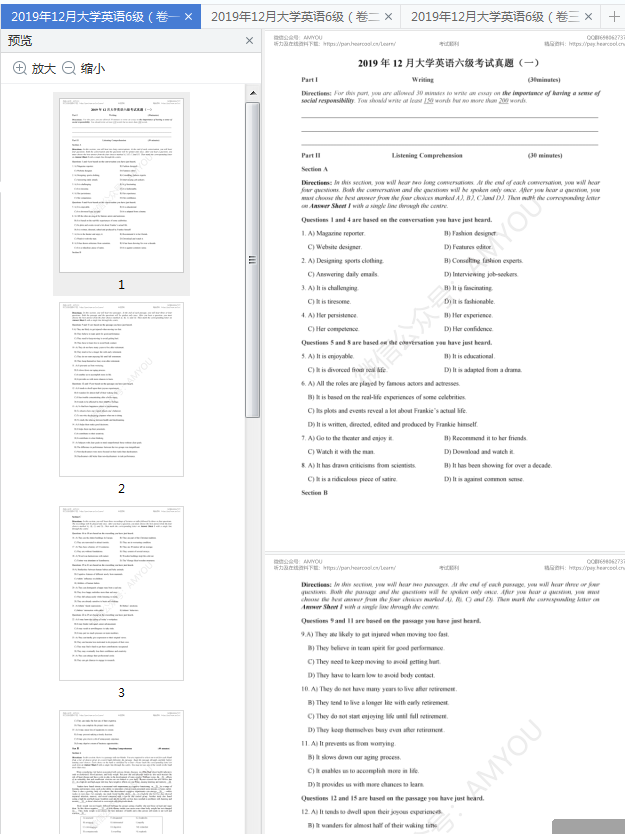
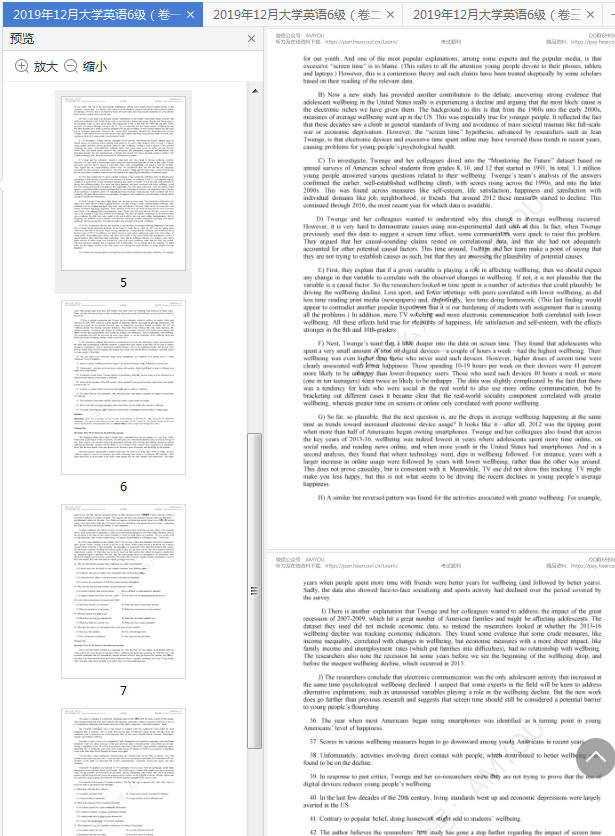
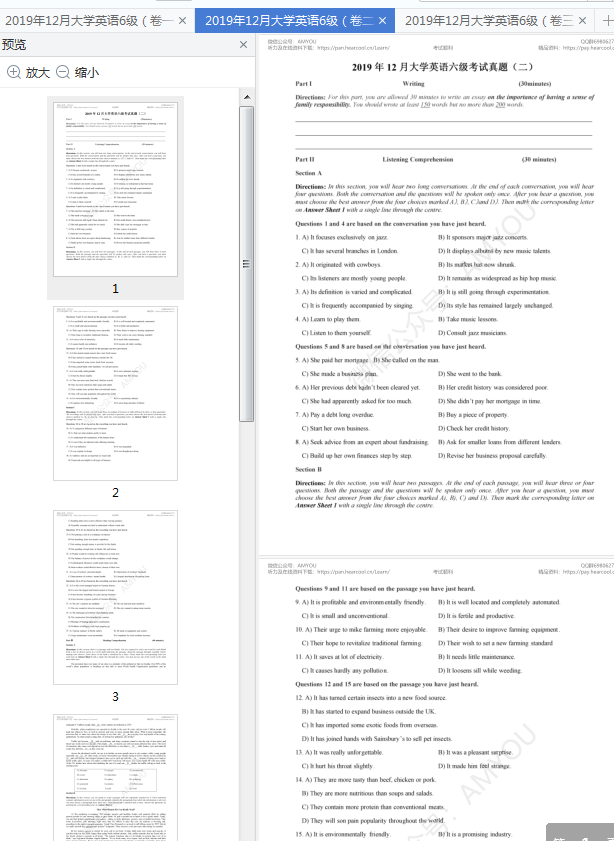
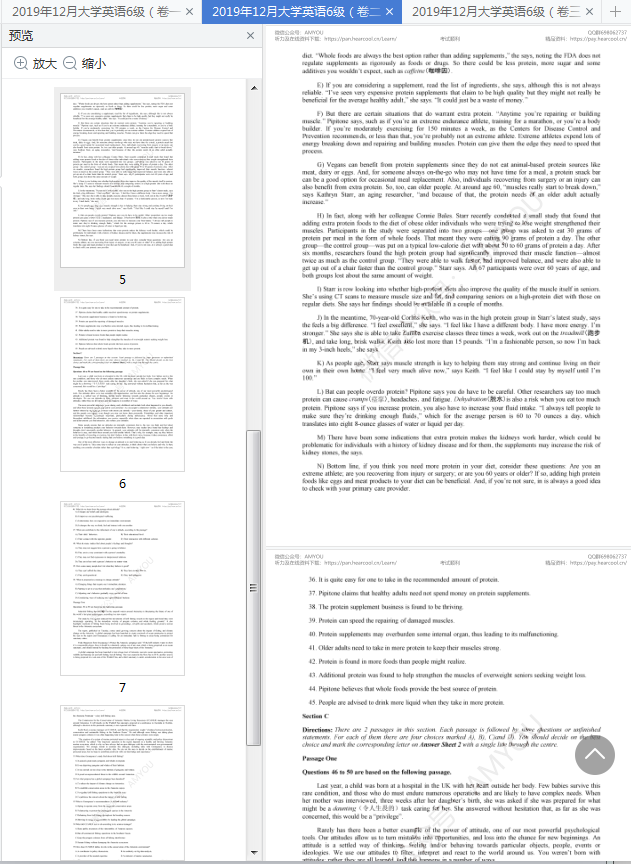
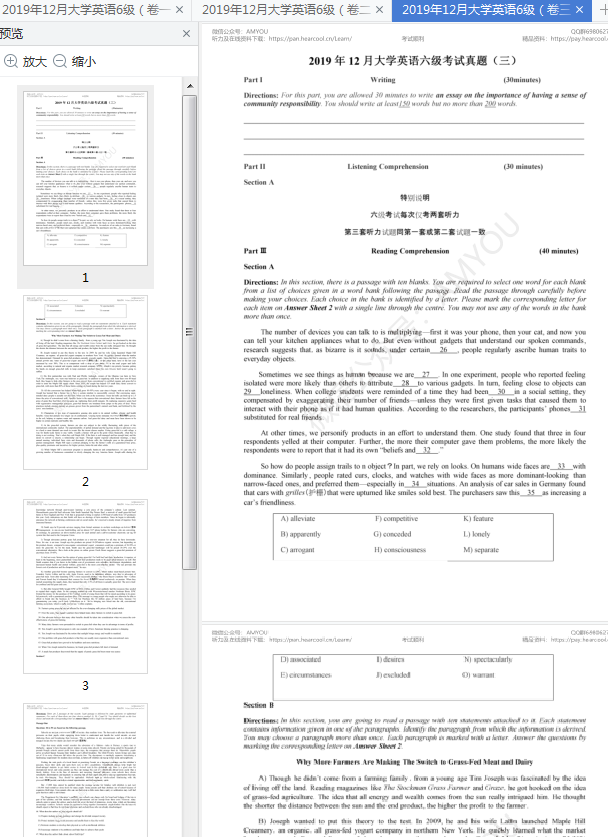
2019年12月六级真题试卷原题预览
Part I Writing (30 minutes)
Directions : For this part, you are allowed 30 minutes to write an essay on the importance of having a sense of social responsibility. You should write at least 150 words but no more than 200 words.
Part II Listening Comprehension (25 minutes)
音频在线收听:2019年12月英语六级听力第1套
Section A
Conversation 1.
1. A) It focuses exclusively on jazz.
B) It sponsors major jazz concerts.
C) It has several branches in London.
D) It displays albums by new music talents.
2. A) It originated with cowboys.
B) Its market has now shrunk.
C) Its listeners are mostly young people.
D) It remains as widespread as hip hop music.
3. A) Its definition is varied and complicated.
B) It is still going through experimentation.
C) It is frequently accompanied by singing.
D) Its style has remained largely unchanged.
4. A) Learn to play them.
B) Take music lessons.
C) Listen to them yourself.
D) Consul jazz musicians.
Conversation 2.
5. A) She paid her mortgage.
B) She called on the man.
C) She made a business plan.
D) She went to the bank.
6. A) Her previous debt hadn’t been cleared yet.
B) Her credit history was considered poor.
C) She had apparently asked for too much.
D) She didn’t pay her mortgage in time.
7. A) Pay a debt long overdue.
B) Buy a piece of property.
C) Start her own business.
D) Check her credit history.
8. A) Seek advice from an expert about fund raising.
B) Ask for smaller loans from different lenders.
C) Build up her own finances step by step.
D) Revise her business proposal carefully.
Section B
Passage 1.
9. A) It is profitable and environmentally friendly.
B) It is well located and completely automated.
C) It is small and unconventional.
D) It is fertile and productive.
10.A) Their urge to make farming more enjoyable.
B) Their desire to improve farming equipment.
C) Their hope to revitalize traditional farming.
D) Their wish to set a new farming standard
11.A) It saves a lot of electricity.
B) It needs little maintenance.
C) It causes hardly any pollution.
D) It loosens soil while weeding.
Passage 2.
12.A) It has turned certain insects into a new food source.
B) It has started on expand business outside the UK.
C) It has imported some exotic foods from overseas.
D) It has joined hands with Sainsbury’s to sell pet insects.
13.A) It was really unforgettable.
B) It was a pleasant surprise.
C) It hurt his throat slightly.
D) It made him feel strange.
14.A) They are more tasty than beef, chicken or pork.
B) They are more nutritious than soups and salads.
C) They contain more protein than conventional meats.
D) They will soon gain popularity throughout the world.
15.A) It is environmentally friendly.
B) It is a promising industry.
C It requires new technology.
D) It saves huge amounts of labour.
Section C
Recording 1
16. A)To categorize different types of learners.
B) To find out what students prefer to learn.
C) To understand the mechanism of the human brain.
D) To see if they are inherent traits affecting learning.
17. A) It was defective.
B)It was misguided.
C) It was original in design.
D) It was thought-provoking.
18. A) Auditory aids are as important as visual aids.
B) Visual aids are helpful to all types of learners.
C) Reading plain texts is more effective than viewing pictures.
D) Scientific concepts are hard to understand without visual aids.
Recording 2
19. A) Not playing a role in a workplace revolution.
B) Not benefiting from free-market capitalism.
C) Not earning enough money to provide for the family.
D) Not spending enough time on family life and leisure.
20. A) People would be working only fifteen hours a week now.
B) The balance of power in the workplace would change.
C) Technological advances would create many new jobs.
D) Most workers could afford to have a house of their own.
21. A) Loss of workers’personal dignity.
B) Deprivation of workers’creativity.
C) Deterioration of workers’mental health.
D) Unequal distribution of working hours.
Recording 3
22. A) It is the worst managed airport in German history.
B) It is now the biggest and busiest airport in Europe.
C) It has become something of a joke among Germans.
D) It has become a typical symbol of German efficiency.
23. A) The city’s airports are outdated.
B) The city had just been reunified.
C) The city wanted to boost its economy.
D) The city wanted to attract more tourists.
24. A) The municipal government kept changing hands.
B) The construction firm breached the contract.
C) Shortage of funding delayed its construction.
D) Problems of different kinds kept popping up.
25. A) Tourism industry in Berlin suffers.
B)All kinds of equipment gets rusted.
C) Huge maintenance costs accumulate.
D) Complaints by local residents increase.
Part Ⅲ Reading Comprehension (40 minutes)
Section A 选词填空
Directions: In this section, there is a passage with ten blanks. You are required to select one word for each blank from a list of choices given in a word bank following the passage. Read the passage through carefully before making your choices. Each choice in the bank is identified by a letter. Please mark the corresponding letter for each item on Answer Sheet 2 with a single line through the centre. You may not use any of the words in the bank more than once.
When considering risk factors associated with serious chronic diseases, we often think about health indicators such as cholesterol, blood pressure, and body weight. But poor diet and physical inactivity also each increase the risk of heart disease and have a role to play in the development of some cancers. Perhaps worse, the 26 effects of an unhealthy diet and insufficient exercise are not limited to your body. Recent research has also shown that 27 in a high-fat and high-sugar diet may have negative effects on your brain, causing learning and memory 28 .
Studies have found obesity is associated with impairments in cognitive functioning, as 29 by a range of learning and memory tests, such as the ability to remember a list of words presented some minutes or hours earlier. There is also a growing body of evidence that diet-induced cognitive impairments can emerge 30 -within weeks or even days. For example, one study found healthy adults 31 to a high-fat diet for five days showed impaired attention, memory, and mood compared with a low-fat diet control group. Another study also found eating a high-fat and high-sugar breakfast each day for as little as four days resulted in problems with learning and memory 32 to those observed in overweight and obese individuals.
Body weight was not hugely different between the groups eating a healthy diet and those on high fat and sugar diets. So this shows negative 33 of poor dietary intake can occur even when body weight has not changed 34 . Thus, body weight is not always the best indicator of health and a thin person still needs to eat well and exercise 35 .
A) assessed
B) assigned
C) consequences
D) conspicuously
E) deficits
F) designated
G) detrimental
H) digestion
I) excelling
J) indulging
K) loopholes
L) rapidly
M) redundant
N) regularly
O) similar
Section B 段落匹配
Directions: In this section, you are going to read a passage with ten statements attached to it. Each statement contains information given in one of the paragraphs. Identify the paragraph from which the information is derived. You may choose a paragraph more than once. Each paragraph is marked with a letter. Answer the question by marking the corresponding letter on Answer Sheet 2.
Increased Screen Time and Wellbeing Decline in Youth
[A] Have young people never had it so good? Or do they face more challenges than any previous generation? Our current era in the West is one of high wealth. This means minors enjoy material benefits and legal protections that would have been the envy of those living in the past. But there is an increasing suspicion that all is not well for our youth. And one of the most popular explanations, among some experts and the popular media, is that excessive “screen time” is to blame (This refers to all the attention young people devote to their phones, tablets and laptops). However, this is a connection theory and such claims have been treated skeptically by some scholars based on their reading of the relevant data.
[B] Now a study in the journal Emotion has provided another contribution to the debate, uncovering strong evidence that adolescent wellbeing in the United States really is experiencing a decline and arguing that the most likely cause is the electronic riches we have given them. The background to this is that from the 1960s into the early 2000s, measures of average wellbeing went up in the US. This was especially true for younger people. It reflected the fact that these decades saw a climb in general standards of living and avoidance of mass societal traumas like full-scale war or economic deprivation. However, the “screen time” hypothesis, advanced by researchers such as Jean Twenge, is that electronic devices and excessive time spent online may have reversed these trends in recent years, causing problems for young people’s psychological health.
[C] To investigate, Twenge and her colleagues dived into the “Monitoring The Future” dataset based on annual surveys of American school students from grades 8, 10, and 12 that started in 1991. In total, 1.1 million young people answered various questions related to their wellbeing. Twenge’s team’s analysis of the answers confirmed the earlier, well-established wellbeing climb, with scores rising across the 1990s, and into the later 2000s. This was found across measures like self-esteem, life satisfaction, happiness and satisfaction with individual domains like job, neighborhood, or friends. But around 2012 these measures started to decline. This continued through 2016, the most recent year for which data is available.
[D] Twenge and her colleagues wanted to understand why this change in average wellbeing has occurred. However, it’s very hard to demonstrate causes in non-experimental data such as this. In fact, when Twenge previously used this data to suggest a screen time effect, some commentators were quick to raise this problem. They argued that her causal-sounding claims rested on correlational data, and that she had not adequately accounted for other potential causal factors. This time around, Twenge and her team make a point of saying that that they are not trying to establish causes as such, but that they are assessing the plausibility of potential causes.
[E] First, they explain that if a given variable is playing a causal role in affecting wellbeing, then we should expect any change in that variable to correlate with the observed changes in wellbeing. If not, it isn’t plausible that the variable is a causal factor. So the researchers looked at time spent in a number of activities that could plausibly be driving the wellbeing decline. Less sport, and fewer meetings with peers correlated with lower wellbeing, as did less time reading print media (newspapers) and, surprisingly, less time doing homework (This last finding would appear to contradict another popular hypothesis that it is our burdening of students with assignments that is causing all the problems). In addition, more TV watching and more electronic communication both correlated with lower wellbeing. All these effects held true for measures of happiness, life satisfaction and self-esteem, with the effects stronger in the 8th and 10th-graders.
[F] Next, Twenge’s team dug a little deeper into the data on screen time. They found that adolescents who spent a very small amount of time on digital devices—a couple of hours—had the highest wellbeing. Their wellbeing was even higher than those who never used such devices. However, higher doses of screen time were clearly associated with lower happiness. Those spending 10-19 hours per week on their devices were 41 percent more likely to be unhappy than lower-frequency users. Those who used such devices 40 hours a week or more (one in ten of teenagers) were twice as likely to be unhappy. The data was slightly complicated by the fact that there was a tendency for kids who were social in the real world to also use more online communication, but by bracketing out different cases it became clear that the real-world sociality component correlated with greater wellbeing, whereas greater time on screens or online only correlated with poorer wellbeing.
[G] So far, so plausible. But the next question is, are the drops in average wellbeing happening at the same time as trends toward increased electronic device usage? It looks like it—after all, 2012 was the tipping point when more than half of Americans began owning smartphones. Twenge and her colleagues also found that across the key years of 2013-16, wellbeing was indeed lowest in years where adolescents spent more time online, on social media, and reading news online, and when more youth in the US had smartphones. And in a second analysis, they found that where technology went, dips in wellbeing followed. For instance, years with a larger increase in online usage were followed by years with lower wellbeing, rather than the other way around. This does not prove causality, but is consistent with it. Meanwhile, TV use didn’t show this tracking. TV might make you less happy, but this is not what seems to be driving the recent declines in young people’s average happiness.
[H] A similar but reversed pattern was found for the activities associated with greater wellbeing. For example, years where people spent more time with friends were better years for wellbeing (and followed by better years). Sadly, the data also showed face-to-face socializing and sports activity had declined over the period covered by the survey.
[I] There is another explanation that Twenge and her colleagues wanted to address: the impact of the great recession of 2007-2009, which hit a great number of American families and might be affecting adolescents. The dataset didn’t include economic data, so instead the researchers looked at whether the 2013-16 wellbeing decline was tracking economic indicators. They found some evidence that some crude measures, like income inequality, correlated with changes in wellbeing, but economic measures with a more direct impact, like family income and unemployment rates (which put families into difficulties), had no relationship with wellbeing. The researchers also note that the recession hit some years before we see the beginning of the wellbeing drop, and before the steepest wellbeing decline, which occurred in 2013.
[J] The researchers conclude that electronic communication was the only adolescent activity that increased at the same time psychological wellbeing declined. I suspect that some experts in the field will be keen to address alternative explanations, such as unassessed variables playing a role in the wellbeing decline. But the new work does go further than before and suggests that screen time should still be considered a potential barrier to young people’s flourishing.
36. The year when most Americans began using smartphones was identified as a turning point in young Americans’ level of happiness.
37. Scores in various wellbeing measures began to go downward among young Americans in recent years.
38. Unfortunately, activities involving direct contact with people, which contributed to better wellbeing, were found to be on the decline.
39. In response to past critics, Twenge and her co-researchers stress they are not trying to prove that the use of digital devices reduces young people’s wellbeing.
40. In the last few decades of the 20th century, living standards went up and economic depressions were largely averted in the US.
41. Contrary to popular belief, doing homework might add to students’ wellbeing.
42. The author believes the researchers’ new study has gone a step further regarding the impact of screen time on wellbeing.
43. The researchers found that extended screen time makes young people less happy.
44. Data reveals that economic inequality rather than family income might affect people’s wellbeing.
45. Too much screen time is widely believed to be the cause of unhappiness among today’s young people.
Section C 仔细阅读
Directions: There are 2 passages in this section. Each passage is followed by some questions or unfinished statements. For each of them there are four choices marked A), B), C) and D). You should decide on the best choice and mark the corresponding letter on Answer Sheet 2 with a single line through the centre.
Passage One
Questions 46 to 50 are based on the following passage.
“The dangerous thing about lying is people don’t understand how the act changes us,” said Dan Ariely, behavioral psychologist at Duke University. Psychologists have documented children lying as early as the age of two. Some experts even consider lying a developmental milestone, like crawling and walking, because it requires sophisticated planning, attention and the ability to see a situation from someone else’s perspective to manipulate them. But, for most people, lying gets limited as we develop a sense of morality and the ability to self-regulate.
Harvard cognitive neuroscientist Joshua Greene said, for most of us, lying takes work. In studies, he gave study subjects a chance to deceive for monetary gain while examining their brains in a functional MRI machine, which maps blood flow to active parts of the brain. Some people told the truth instantly and instinctively. But others opted to lie, and they showed increased activity in their frontal parietal control network, which is involved in difficult or complex thinking. This suggests that they were deciding between truth and dishonesty—and ultimately opting for the latter. For a follow-up analysis, he found that people whose neural reward centers were more active when they won money were also more likely to be among the group of liars—suggesting that lying may have to do with the inability to resist temptation.
External conditions also matter in terms of when and how often we lie. We are more likely to lie, research shows when we are able to rationalize it, when we are stressed and fatigued or see others being dishonest. And we are less likely to lie when we have moral reminders or when we think others are watching. “We as a society need to understand that, when we don’t punish lying, we increase the probability it will happen again,” Ariely said.
In a 2016 study published in the journal Nature Neuroscience, Ariely and colleagues showed how dishonesty alters people’s brains, making it easier to tell lies in the future. When people uttered a falsehood, the scientists noticed a burst of activity in their amygdala. The amygdala is a crucial part of the brain that produces fear, anxiety and emotional responses—including that sinking, guilty feeling you get when you lie. But when scientists had their subjects play a game in which they won money by deceiving their partner, they noticed the negative signals from the amygdala began to decrease. Not only that, but when people faced no consequences for dishonesty, their falsehoods tended to get even more sensational. This means that if you give people multiple opportunities to lie for their own benefit, they start with little lies and get bigger and bigger over time.
46. Why do some experts consider lying a milestone in a child’s development?
A) It shows they have the ability to view complex situations from different angles.
、B) It indicates they have an ability more remarkable than crawling and walking.
C) It represents their ability to actively interact with people around them.
D) It involves the coordination of both their mental and physical abilities.
47. Why does the Harvard neuroscientist say that lying takes work?
A) It is difficult to sound natural or plausible.B) It is hard to choose from several options.
C) It involves lots of sophisticated mental activity.D) It requires speedy blood flow into one’s brain.
48. Under what circumstances do people tend to lie?
A) When they become too emotional.B) When they face too much peer pressure.
C) When the temptation is too strong.D) When the consequences are not imminent.
49. When are people less likely to lie?
A) When they are worn out and stressed.B) When they are under watchful eyes.
C) When they think in a rational way.D) When they have a clear conscience.
50. What does the author say will happen when a liar does not get punished?
A) They may feel justified.B) They will tell bigger lies.
C) They will become complacent.D) They may mix lies and truths.
Passage Two
Questions 51 to 55 are based on the following passage.
Here’s how the Pacific Northwest is preparing for “The Big One”. It’s the mother of all disaster drills for what could be the worst disaster in American history. California has spent years preparing for “The Big One”—the inevitable earthquake that will undoubtedly unleash all kinds of havoc along the famous San Andreas fault. But what if the fault that runs along the Pacific Northwest delivers a gigantic earthquake of its own? If the people of the Cascadia region have anything to do with it, they won’t be caught unawares.
The region is engaged in a multi-day earthquake and tsunami drill involving around 20,000 people. The Cascadia Rising drill gives area residents and emergency responders a chance to practice what to do in case of a 9.0 magnitude earthquake and tsunami along one of the nation’s dangerous—and underestimated—faults.
The Cascadia Subduction Zone is big enough to compete with San Andreas (it’s been called the most dangerous fault in America), but it’s much lesser known than its California cousin. Nearly 700 miles long, the earthquake zone is located by the North American Plate off the coast of Pacific British Columbia, Washington, Oregon and Northern California.
Cascadia is what’s known as a “megathrust” fault. Megathrusts are created in subduction zones—land plate boundaries where two plates converge. In the areas where one plate is beneath another, stress builds up over time. During a megathrust event, all of that stress releases and some of the world’s most powerful earthquakes occur. Remember the 9.1 earthquake and tsunami in the Indian Ocean off of Sumatra in 2004? It was caused by a megathrust event as the India plate moved beneath the Burma micro-plate.
The last time a major earthquake occurred along the Cascadia fault was in 1700, so officials worry that another event could occur at any time. To prevent that event from becoming a catastrophe, first responders will join members of the public in rehearsals that involve communication, evacuation, search and rescue, and other scenarios.
Thousands of deaths and other casualties are expected if a 9.0 earthquake were to occur. First, the earthquake would shake metropolitan areas including Seattle and Portland. This could trigger a tsunami that would create havoc along the coast. Not all casualties can necessarily be prevented—but by coordinating across local, state, and even national borders, officials hope that the worst-case scenario can be averted. On the exercise’s website, officials explain that the report they prepare during this rehearsal will inform disaster management for years to come.
For hundreds of thousands of Cascadia residents, the big one isn’t a question of if, only when. And it’s never too early to get ready for the inevitable.
51. What does “The Big One” refer to?
A) A gigantic geological fault.
B) A large-scale exercise to prepare for disasters.
C) A massive natural catastrophe.
D) A huge tsunami on the California coast.
52. What is the purpose of the Cascadia Rising drill?
A) To prepare people for a major earthquake and tsunami.
B) To increase residents’ awareness of imminent disasters.
C) To teach people how to adapt to post-disaster life.
D) To cope with the aftermath of a possible earthquake.
53. What happens in case of a megathrust earthquake according to the passage?
A) Two plates merge into one.
B) Boundaries blur between plates.
C) A variety of forces converge.
D) Enormous stress is released.
54. What do the officials hope to achieve through the drills?
A) Coordinating various disaster-relief efforts.
B) Reducing casualties in the event of a disaster.
C) Minimizing property loss caused by disasters.
D) Establishing disaster and emergency management.
55. What does the author say about “The Big One”?
A) Whether it will occur remains to be seen.
B) How it will arrive is too early to predict.
C) Its occurrence is just a matter of time.
D) It keeps haunting Cascadia residents.
Part Ⅳ Translation (30 minutes)
Directions: For this part, you are allowed 30 minutes to translate a passage from Chinese into English. You should write your answer on Answer Sheet 2.
牡丹花色艳丽,形象高雅,象征这和平与繁荣,因而在中国被称为”花中之王”。中国许多地方都培育和种植牡丹。千百年来,创造了许多诗歌和绘画赞美牡丹。唐代时期,牡丹在皇家园林普遍种植并被誉为国花,因而特别风行。十世纪时,洛阳古城成为牡丹栽培中心,而且这一地位一直保持到今天。现在,成千上万的国内游客蜂拥到洛阳参加一年一度的牡丹节欣赏洛阳牡丹的独特之美,同时探索九朝古都的历史。
2019年12月六级真题试卷答案
【写作答案】参考范文
The Importance of Having a Sense of Social Responsibility
As we all know, responsibility is one of the most basic qualities. If we give up the responsibility, we are equal to give up the whole world. As far as I am concerned, we should have a high sense of responsibility to become an upright person.
How can we cultivate social responsibility? To start with, children should be taught about good moral outlooks, so that when they grow up, they will become law-abiding and responsible citizens. Furthermore, the humanistic education is vital, especially for us university students because we are the future pillars of our country. Last but not least, it is necessary to encourage people to care for others, help others through all kinds of propaganda, because each individual is closely related to and bears obligations to others.
If all the citizens have a sound sense of social responsibility, it is hopeful that the world will enjoy a better future. Therefore, let's take our social responsibility and contribute to our society.
【听力答案】
1-8. ABACDBCB, 9-15:CDDABCA,16-25:DAADACCBDC
【阅读理解】答案
【选词填空-参考答案】26-30 GJEAL 31-35 BOCDN
26. G) detrimental
27. J) indulging
28. E) deficits
29. A) assessed
30. L) rapidly
31. B) assigned
32. O) similar
33. C) consequences
34. D) conspicuously
35. N) regularly
【段落匹配-参考答案】
36-45GCHDB EJFIA
Passage One—The dangerous thing about lying
46-50 ADBBB
46. A) It shows they have the ability to view complex situations from different angles.
47. D) It involves lots of sophisticated mental activity.
48. B) When they face too much peer pressure.
49. B) When they are under watchful eyes.
50. B) They will tell bigger lies.
Passage Two—Here is how.
51-55 CADBC
51. C) A massive natural catastrophe
52. A) To prepare people for a major earthquake and tsunami
53. D) Enormous stress is released
54. B) Reducing casualties in the event of a disaster
55. C) Its occurrence is just a matter of time
【翻译答案】参考译文 (牡丹花)
The peony, with its rich colors and elegant images, symbolizes peace and prosperity and is known as the "king of flowers" in China. Peony is cultivated in many parts of China. For thousands of years, many poems and paintings have been created in praise of peonies. During the Tang Dynasty, peonies were widely planted in the imperial gardens and known as the national flower, so they were very popular. In the 10th century, the ancient city of Luoyang became a center for peony cultivation and remains so today. Now, tens of thousands of tourists from home and abroad flock to Luoyang for the annual peony festival to admire the unique beauty of the city's peonies and explore the history of the ancient capital of nine dynasties.
三、听力原文
Conversation 1.
M: Excuse me. "Where's your rock music section?
W: Rock music? I'm sorry, we're a Jazz store. We don't have anyrock and roll.
M: Oh, you only have Jazz music, nothing else.
W: That's right. (1)We're the only record store in London dedicated exclusively to Jazz.Actually, we're more than just a record store. We have a cafe and libraryupstairs and a ticket office down the hall where you can buy tickets to all themajor Jazz concerts in the city. Also we have our own studio next door wherereproduce albums for up and coming artists. We are committed to fostering newmusic talent.
M: That's so cool. (2)1 guess there's not much of a Jazz scene anymore. Not like they usedto be. But here you're trying to promote this great music genre.
W: Yes. Indeed, nowadays most people like to listen to pop and rockmusic. Hip hop music from America is also getting more and more popular. So asa result, there are fewer listeners of Jazz, which is a great shame becauseit's an incredibly rich genre. But that's not to say there isn't any good newJazz music being made out there anymore. Far from it. It's just a much smallermarket today.
M: So how would you define Jazz?
W: Interestingly enough, there's no agreed upon definition of Jazz.(3) Indeed, there are manydifferent styles of Jazz, some have singing, but most don't. Some areelectric and some aren't. Some contain live experimentation, but not always.(3) While there's no simple definition for it. Allow, there are many differentstyles of Jazz. You simply know it when you hear it. Honestly. (4) The only way to know whatJazz is, listen to it yourself. As the great trumpet player. LouisArmstrong said, if you've got to ask, you'll never know.
Question 1. What do we learn about the woman's store?
Question 2. What does the man say about Jazz music?
Question 3. What does the woman say about Jazz?
Question 4. What should you do to appreciate different styles ofJazz according to the woman?
Conversation 2.
M: How did it go at the bank this morning?
W: Not well. My proposal was rejected.
M: Really? But why?
W: Bunch of reasons. For starters, they said my credit history wasnot good enough.
M: Did they say, how you could improve that?
W: Yes, they said that after five more years of paying my mortgage,then I will become a more viable candidate for a business loan. But right nowit's too risky for them to lend me money. They fear I will default on anybusiness loan I'm given.
M: That doesn't sound fair. Your business idea is amazing. Did youshow them your business plan? What did they say?
W: They didn't really articulate any position regarding the actualbusiness plan. They simply looked at my credit history and determined it wasnot good enough. They said the bank has strict guidelines and requirements asto who they can lend money to. And I simply don't meet their financialthreshold.
M: What if you ask for a smaller amount? Maybe you could gathercapital from other sources, smaller loans from more lenders.
W: You don't get it. It doesn't matter. The size of the loan I askfor, or the type of business I propose. That's all inconsequential. The firstthing every bank will do is study how much money I have and how much debt Ihave before they decide whether or not to lend me any more money. If I want tocontinue ahead with this dream of only my own business, I have no other choice.But to build up my own finances, I need around 20% more in personal savings and50% less debt. That's all there is to it.
M: I see now it's a huge pity that they rejected your request, butdon't lose hope. I still think that your idea is great and that you would turnit into a phenomenal success.
Question 5. What did the woman do this morning?
Question 6. Why was the woman's proposal rejected?
Question 7. What is the woman planning to do?
Question 8. What does the man suggest the woman do?
Section B.
Passage 1.
There's a lot about Leo Sanchez and his farm in Salinas,California. (9) That seems unusual. The national average farm size is around440 acres, but his is only one acre.
The average age of farmers hovers around 58 years old, but he isjust 26. And Sanchez constantly attempts to improve everything from seedingtechniques out in the field to the promotion and sale of his produce online.This is evidence of an experimental approach. It's an approach not dictated bythe confines of conventional large scale agriculture lead by internationalcorporations. While farming is often difficult for both the body and mine, (10)Sanchez says he and many of his fellow young farmers are motivated by desire toset a new standard for agriculture.
Many of them are employing a multitude of technologies, some newand some not so new. Recently, (11) Sanchez bought a hand operated tool whichpulls out weeds and loosen soil. It actually dates back to at least 1701. Itstands in sharp contrast to Sanchez, this other gadget, a gas powered flame wekiller, invented in 1997. He simply doesn't discriminate when it comes to thenewness of tools. If it works, it works. Farmers have a long history ofinvention and is no different today. Young farmers are guided by their love foragriculture and aided by their knowledge of technology to find inexpensive andappropriately sized tools. They collaborate and innovate. Sometimes the oldstuff just works better or more efficiently.
Question 9. What do we learn about Leo Sanchez's farm?
Question 10. What has motivated Leo Sanchez and his fellow. youngfarmers to engage in farming?
Question 11. Why did Leo Sanchez buy a hand operated weeding tool?
Passage 2.
(12) Eat Grub is Britain's first new food company that breakswestern food boundaries by introducing edible insects as a new source of food.
And Sainz Breeze is the first UK supermarket to stock the company'scrunchy roasted crickets. Sainz Breeze insist that such food is no joke andcould be a new, sustainable source of protein. Out of curiosity, I paid a visitto Sainz Breeze as I put my hand into a packet of crickets with their tiny eyesand legs. The idea of one going in my mouth made me feel a little sick. (13)But the first bite was a pleasant surprise, a little dry and lacking of taste,but at least a wing didn't get stuck in my throat.
The roasted seasoning largely overpowered any other flavour,although there was slightly bitter after taste. The texture is crunchy, butsmelt a little of cab food. Eat Grub also recommends the crickets as a toppingfor noodles, sou2s and salads. (14) The company boasts that its dried cricketscontain more protein than beef, chicken, and pork, as well as minerals likeiron and calcium. Unlike the production of meat, bugs do not use up largeamounts of land, water or feed. (15) And insect farming also produces far fewergreenhouse gases.
However, despite 2 billion people worldwide already supplementingtheir diet with insects, consumer disgust remains a large barrier in manywestern countries. I'm not sure bugs will become a popular snack anytime soon,but they're definitely food for fort.
Question 12. What do we learn from the passage about the foodcompany Eat Grub ?
Question 13. What does the speaker say about his first bite aroasted crickets ?
Question 14. What does Eat Grub say about his dried crickets?
Question 15. What does the passage say about insect farming?
Section C
Recording 1.
Have you ever had someone try to explain something to you a dozentimes with no luck? But then when you see a picture, the idea finally clicks.If that sounds familiar, maybe you might consider yourself a visual learner. Orif reading or listening does a trick, maybe you feel like you're a verballearner. We call these labels learning styles. But is there really a way tocategorize different types of students? It actually seems that multiplepresentation formats, especially if one of them is visual. Help most peoplelearn. When psychologists and educators test for learning styles, they'retrying to figure out whether these are inherent traits that affect how wellstudents learn instead of just a preference.
Usually they start by giving a survey to figure out what style astudent favors, like visual or verbal learning. Then they try to teach thestudents something with a specific presentation style, like using visual AIDS,and do a follow up test to see how much they learned. That way, the researcherscan see if the self identified verbal learners really learned better when theinformation was just spoken aloud, for example. But according to a 2008 review,only one study that followed this design found that students actually learnedbest with their preferred style.
But the study had some big flaws. The researchers excluded 2/3 ofthe original participants, because they didn't seem to have any clear learningsty le from the survey at the beginning. And they didn't even report the actualtest scores in the final paper. So it doesn't really seem like learning stylesare an inherited trait that we all have. But that doesn't mean that allstudents will do amazingly, if they just spend all their time reading from atextbook. Instead, most people seem to learn better if they're taught inseveral ways, especially if one is visual.
In one study, researchers tested whether students remembered listsof words better if they heard them, saw them or both. Everyone seemed to dobetter. If they got to see the words in print. Even the self identifiedauditory learners, their preference didn't seem to matter. Similar studiestested whether students learned basic physics and chemistry concepts better byreading plain text or viewing pictures to and everyone to better with the helpof pictures.
Question 16. Why do psychologists and educators study learningstyles?
Question 1 7. What does the speaker say about one study mentionedin the 2008 review?
Question 18. What message does the speaker want to convey aboutlearning at the end of the talk?
Recording 2.
Free market capitalism hasn't freed us. It has trapped us. It'simperative for us to embrace a workplace revolution. We're unlikely to spendour last moments regretting that we didn't spend enough of our lives slavingaway at work. We may instead find ourselves feeling guilty about the time wedidn't spend watching our children grow all with our loved ones, or travellingor on the cultural or leisure suits that bring us happiness.
Unfortunately, the average full time employee in the world works 42hours a week. Over a 3rd of the time we're awake. Some of our all too precioustime is being stolen. Office workers do around 2 billion hours of unpaidovertime each year. So it's extremely welcome that some government coalitionshave started looking into potentially cutting the working week to four days.The champions of free market capitalism promised their way of life would bringus freedom, but it wasn't freedom at all. From the lack of secure, affordablehousing to growing job insecurity and rising personal debt, the individual istrapped.
Nine decades ago, leading economists predicted that technological advancesand rising productivity would mean that would be working a 15-hour week. By nowthat target has been somewhat missed. Here is the most malignant threat to ourpersonal freedom, particularly as the balance of power in the workplace hasbeen shifted so dramatically from worker to boss. A huge portion of our livesinvolves the surrender of our freedom and personal autonomy. It's time in whichwe are directed by the needs and desires of others, and denied the right tomake our own choices.
That's bad for us. It's hardly surprising that over half a millionworkers suffer from work related mental health conditions. Each year. All that15.4 million working days were lost to work related stress last year, a jump ofnearly a quarter. Yes, they're all those who, far from being overworked,actually seek more hours. But a shorter working week would enable us toredistribute hours from the overworked to the under worked. We need to look atways of cutting the working week without slashing living standards.
After all worlds, workers have already suffered the worst deductionin wages since the early 18 hundreds. And cutting the working week would beconducive to the individual, giving millions of workers more time to spend asthey see fit.
Question 19. What do people often feel guilty about according tothe speaker?
Question 20. What did leading economists predict 90 years ago?
Question 21. What is the result of denying workers' right to maketheir own choices?
Recording 3.
Today I'm going to talk about Germany's dream airport in Berlin.The airport looks exactly like every- other major modern airport in Europe,except for one big problem. More than seven years after it was originallysupposed to open, it still stands empty. Germany is known for its efficiencyand refined engineering, but when it comes to its new ghost airport, thisreputation could not be further from the truth. Plagued by long delays,perpetual mismanagement, and ever saw ring costs, the airport has becomesomething of a joke among Germans and a source of frustration for localpoliticians, business leaders and residents alike.
Planning for the new airport began in 1989. At the time, it becameclear that the newly reunified Berlin would need a modern airport with fargreater capacity than its existing airports. The city broke ground on the newairport in 2006. The first major sign of problems came in summer 2010, when theconstruction corporation pushed the opening from October 2011 to June 2012. In2012, the city planted opening ceremony. But less than a month before hand,inspectors found significant problems with the fire safety system and push theopening back again to 2013.
It wasn't just the smoke system. Many other major problemssubsequently emerged. More than 90 meters of cable were incorrectly installed.4000 doors were wrongly numbered. Escalators were too short. There was ashortage of check in desks. Why were so many problems discovered? Didn't theairport corporation decide to give up on the project and start over? The reasonis simple. People are often hesitant to terminate a project when they'vealready invested time or resources into it, even if it might make logical senseto do so.
The longer the delays continued, the more problems inspectorsfound. Leadership of the planning corporation has changed hands nearly as manytimes as the opening date has been pushed back. Initially, rather thanappointing a general contractor to run the project, the corporation decided tomanage it themselves. Despite lack of experience with an undertaking of thatscale. To compound the delays, the unused airport is resulting in massivecosts. Every month it remains unopened costs between nine and 10 million euros.Assuming all goes well, the airport should open in October 2020, but the stillempty airport stands as the biggest embarrassment to Germany's reputation forefficiency and a continuing drain on city and state resources.
Question 22. What does the speaker say about the dream airport inBerlin?
Question 23. Why was there a need for a new airport in Berlin?
Question 24. Why did Berlin postpone the opening of its dreamairport again and again?
Question 25. What happens while the airport remains unused?
翻译题目及答案
Directions: For this part, you are allowed 30 minutes to translate a passage from Chinese into English. You should write your answer on Answer Sheet 2.
【翻译原文】
梅花(plum blossom)位居中国十大名花之首,源于中国南方,已有三千多年的栽培和种植历史。隆冬时节,五颜六色的梅花不畏严寒,迎着风雪傲然绽放。在中国传统文化中,梅花象征着坚强、纯洁、高雅,激励人们不畏艰难、砥砺前行。自古以来,许多诗人和画家从梅花中获取灵感,创作了无数不朽的作品。普通大众也都喜爱梅花,春节期间常用于家庭装饰。南京市已将梅花定为市花,每年举办梅花节,成千上万的人冒着严寒到梅花山踏雪赏梅。
【翻译题目】
Directions:For this part, you are allowed 30 minutes to translate a passage from Chinese into English. You should write your answer on Answer Sheet 2.
【翻译原文】
牡丹花色艳丽,形象高雅,象征着和平与繁荣,因而在中国被称为“花中之王”。中国许多地方都培育和种植牡丹。千百年来,创造了许多诗歌和绘画赞美牡丹。唐代时期,牡丹在皇家园林普遍种植并被誉为国花,因而特别风行。十世纪时,洛阳古城成为牡丹栽培中心,而且这一地位一直保持到今天。现在,成千上万的国内游客蜂拥到洛阳参加一年一度的牡丹节,欣赏洛阳牡丹的独特之美,同时探索九朝古都的历史。
2019年12月六级真题试卷共三套pdf免费版截图
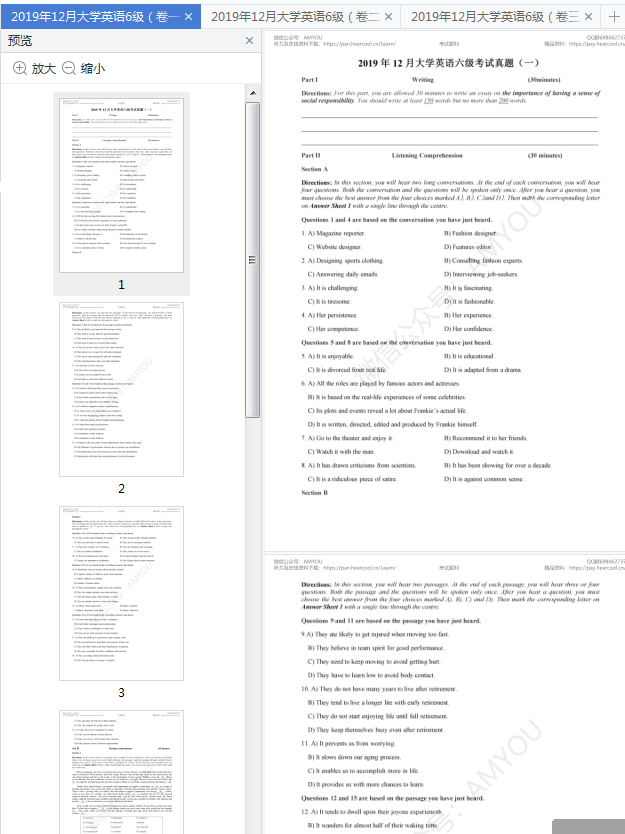
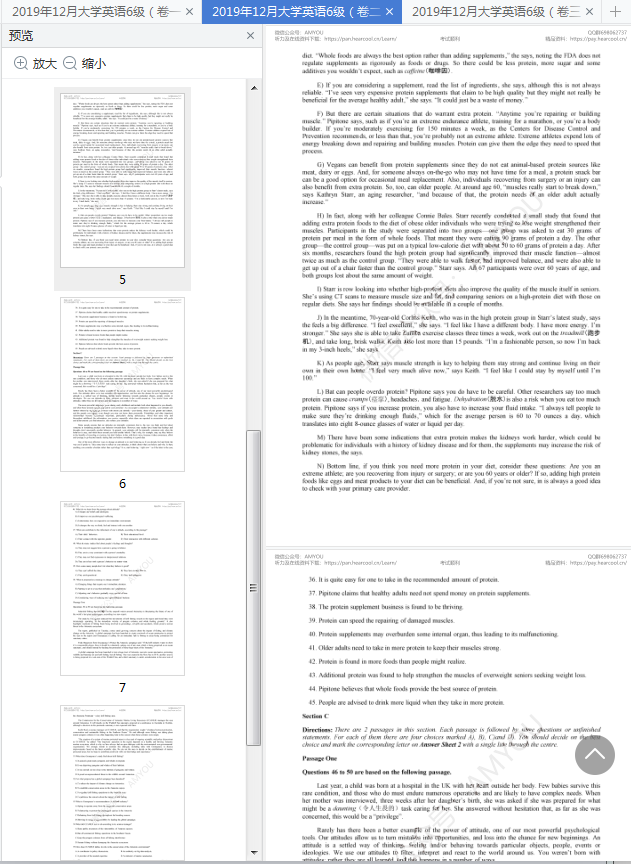
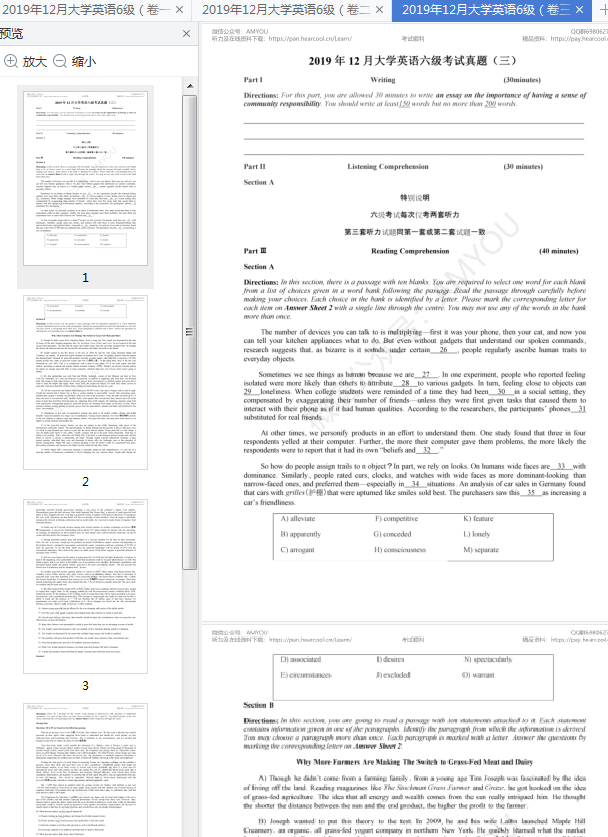


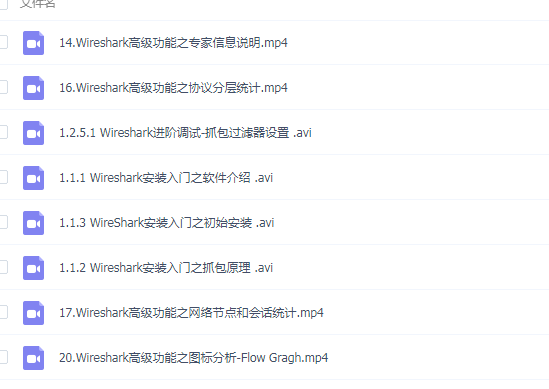








Comments